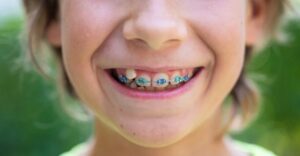Emma, age 10, had crowded front teeth and a slight overbite. Her parents weren’t sure which braces would work best—metal, ceramic, or clear aligners like Invisalign. After visiting a pediatric orthodontist, they learned that the best choice wasn’t just about looks—but comfort, effectiveness, and how responsible Emma was with daily care.
This article will help you, like Emma’s parents, understand the pros and cons of each type of braces and choose what’s best for your child.
Why Do Kids Need Braces?
Braces help straighten teeth, fix bite problems (like overbites or underbites), and guide jaw growth. Most children start treatment between ages 8 and 14, but the exact timing and type of braces depend on your child’s specific needs.
1. Metal Braces – Strong and Reliable
What they are:
Classic silver braces with brackets and wires. Often used with colored rubber bands that kids can change at each appointment.
Pros:
- Most effective for all types of dental problems
- Usually the most affordable
- Kids love choosing fun band colors
Cons:
- Most noticeable
- Can cause mild mouth irritation early on
Best for:
Younger kids or those with moderate to severe issues.
2. Ceramic Braces – Less Noticeable
What they are:
Similar to metal braces, but the brackets are clear or tooth-colored, so they blend in better.
Pros:
- Less visible than metal braces
- Just as effective in most cases
Cons:
- A little more fragile than metal
- May cost more
- Brackets can stain if not cleaned properly
Best for:
Older kids or teens who are self-conscious about appearance.
3. Invisible Braces (Clear Aligners like Invisalign)
What they are:
Custom-made, removable plastic trays that move teeth gradually.
Pros:
- Nearly invisible
- Removable for eating and brushing
- Comfortable—no wires or brackets
Cons:
- Not suitable for complex cases
- Requires discipline to wear 20–22 hours a day
- More expensive than metal braces
Best for:
Responsible preteens or teens with mild to moderate crowding.
How to Choose the Right Type
| Feature | Metal Braces | Ceramic Braces | Clear Aligners |
|---|---|---|---|
| Visibility | Most visible | Less visible | Nearly invisible |
| Strength | Very strong | Moderate | Lower |
| Comfort | May irritate early | Smooth, but bulkier | Most comfortable |
| Removable? | No | No | Yes |
| Cost | $$ | $$$ | $$$$ |
| Good for Complex Cases | ✔️ | ✔️ | ❌ (for mild–moderate) |
Can Kids Just Wait Until They’re Older?
In some cases, yes—but not always.
Some problems, like underbites or jaw growth issues, must be treated early (even at age 7–9) to avoid surgery later. Other minor problems can wait until all adult teeth come in around age 12–14. Your orthodontist will guide you based on your child’s dental development.
Parent Tips:
- Start screening early: Get an orthodontic checkup by age 7
- Don’t wait if there’s a clear issue: Treat jaw or bite problems early
- Match the braces to your child’s lifestyle: Younger kids may do better with metal; teens may prefer Invisalign—but only if they can handle the responsibility
- Visit a board-certified pediatric orthodontist for expert advice













